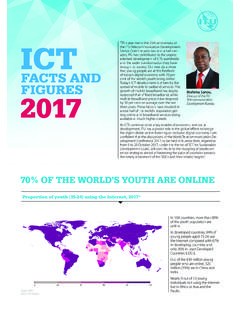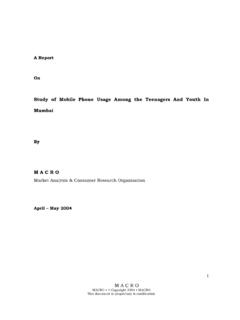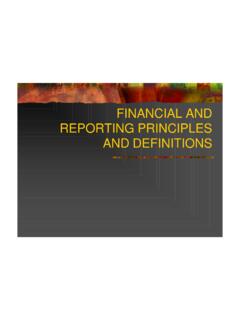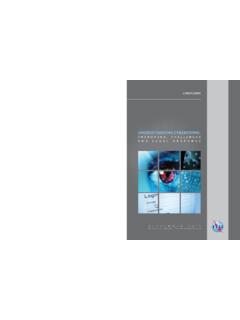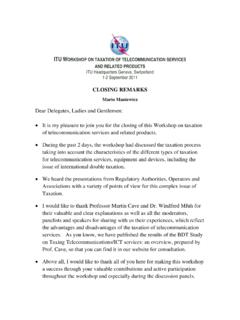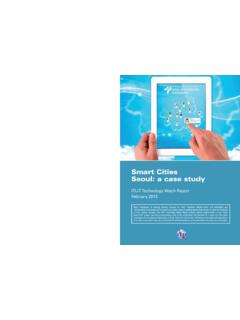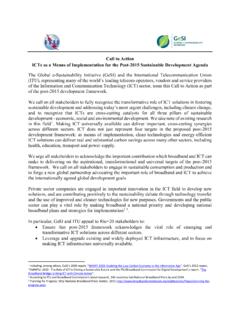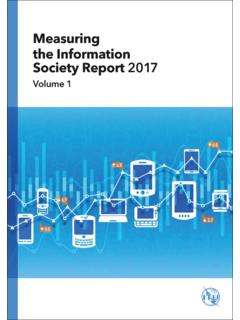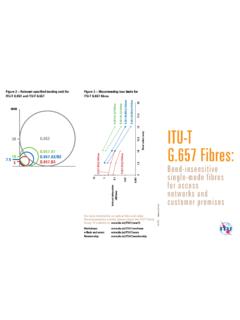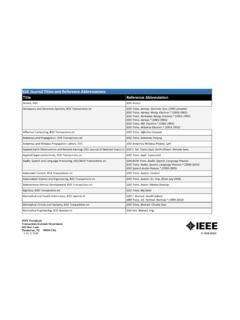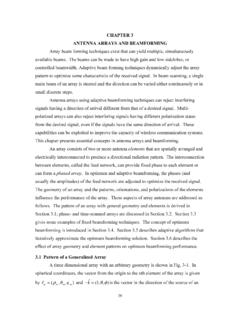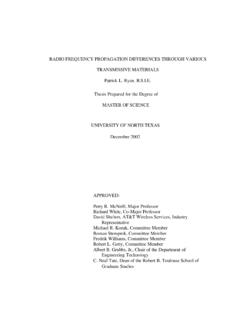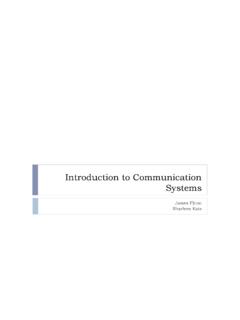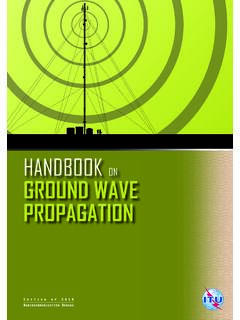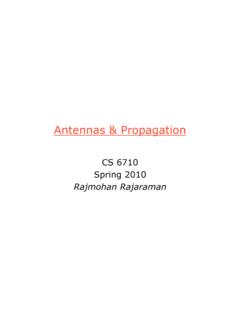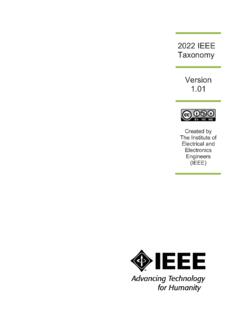Transcription of Small Satellite Link Budget Calculation
1 Small Satellite link BudgetCalculationMarcos Arias (Universidade de Vigo)Fernando Aguado (Universidade de Vigo and de Chile. November 20161/462/46 Critical points in a Satellite LinkReceived powerNoiseSignal to noise ratioConclusionsTable of Contents1 Critical points in a Satellite Link2 Received powerFriis formulaAntennasPolarizationPropagation3 NoiseRadio NoiseAntenna Noise4 Signal to noise ratioRate carrier / noiseDoppler effectEb/N0 Receiver sensitivityInterference5 ConclusionsSmall Satellite link Budget Calculation3/46 Critical points in a Satellite LinkReceived powerNoiseSignal to noise ratioConclusionsCritical)
2 Points in a Satellite LinkCritical points in a Satellite LinkAvailable power at the Ground StationAvailable power at the satelliteSensitivity of the ReceiverSNR at the ReceiverReception level at the Earth to avoid interferencesSmall Satellite link Budget Calculation4/46 Critical points in a Satellite LinkReceived powerNoiseSignal to noise ratioConclusionsRadio link chainSmall Satellite link Budget Calculation5/46 Critical points in a Satellite LinkReceived powerNoiseSignal to noise ratioConclusionsFriis formulaAntennasPolarizationPropagationRE COMMENDATION ITU-R ITU-R formula was first published in 1946: H.
3 T. Friis, A noteon a simple transmission formula, Proc. IRE 34, 254 256(1946)pr=pt (1 | t|2) gt ( 4 d)2 1am gr (1 | r|2), where tand rare the reflection coefficients of the antennas andgtandgrthe gain of the antennaspr=pt (1 | t|2) gt 14 d2 1am Aeff (1 | r|2), whereAeff= 24 gris the effective area of recepctionSmall Satellite link Budget Calculation6/46 Critical points in a Satellite LinkReceived powerNoiseSignal to noise ratioConclusionsFriis formulaAntennasPolarizationPropagationFr ee-space basic transmission lossFree-space basic transmission lossIf the distancedbetween the antennas is much greater thanthe wavelength , the free-space attenuation (free-space basictransmission loss) in decibels will be.
4 Lbf= 20 log10(4 d )With a low-orbit Satellite with elliptical orbit, the distancemust be calculated using the worst case, that means when thesatellite is with the lowest elevation angle and in the directionof the major axis of the ellipseSmall Satellite link Budget Calculation7/46 Critical points in a Satellite LinkReceived powerNoiseSignal to noise ratioConclusionsFriis formulaAntennasPolarizationPropagationMa ximum distanceMaximum distanceThe maximum distance with a Satellite with maximum heightHand minimum elevation angle is.
5 Dmax= REsin + (REsin )2+H2+ 2 RE HSatellite distanceRERE+Hd Small Satellite link Budget Calculation8/46 Critical points in a Satellite LinkReceived powerNoiseSignal to noise ratioConclusionsFriis formulaAntennasPolarizationPropagationHU MSAT: Distance and timeOrbitElevationMaximum linkLinkaltitude (Km)angledistance (Km)time (s)4004059860505124360457306004088290507 61656068345800401159119501006876090761 Small Satellite link Budget Calculation9/46 Critical points in a Satellite LinkReceived powerNoiseSignal to noise ratioConclusionsFriis formulaAntennasPolarizationPropagationRE COMMENDATION ITU-R ITU-R basic transmission loss of a radio link (Lb) is the additionbetween the free-space basic transmission loss (Lbf)
6 And theloss relative to free space (Am):Lb=Lbf+AmMain types of losses for Satellite communications:absorption loss (ionospheric, atmospheric gases orprecipitation)effective reflection or scattering loss as in the ionospheric caseincluding the results of any focusing or defocusing due tocurvature of a reflecting layerpolarization coupling loss from any polarization mismatchbetween the antennas for the particular ray path consideredeffect of wave interference between the direct and reflectedrays from the ground.
7 Other obstacles or atmospheric layersSmall Satellite link Budget Calculation10/46 Critical points in a Satellite LinkReceived powerNoiseSignal to noise ratioConclusionsFriis formulaAntennasPolarizationPropagationAn tenna Gain and BeamwidthAntenna Gain and BeamwidthThe Beamwidth of a pattern is defined as the angularseparation between two identical points on opposite side ofthe pattern maximumOne of the most widely used beamwidths is the Half-PowerBeamwidth (HPBW) that can vary with the azimuth angleAn approximate relation between the antenna gain and itsHPBW isgmax=4 HPBWE HPBWHS mall Satellite link Budget Calculation11/46 Critical points in a Satellite LinkReceived powerNoiseSignal to noise ratioConclusionsFriis formulaAntennasPolarizationPropagationPo larizationPolarizationThe polarization in the link can be Lineal, Horizontal orVertical, or Circular, Left Hand (LHCP) or Right Hand(RHCP)Both antennas ( Satellite and earth station)
8 Should have thesame , using two orthogonal polarizations, radio-linkcapacity can be the double, but a crosspolarizationinterference can appear in the receptionSmall Satellite link Budget Calculation12/46 Critical points in a Satellite LinkReceived powerNoiseSignal to noise ratioConclusionsFriis formulaAntennasPolarizationPropagationRe commendation ITU-R data and prediction methods required for the designof Earth-space telecommunication systemsIn the design of Earth-space links for communication systems,several effects must be considered:absorption in atmospheric gases.
9 Absorption, scattering anddepolarization by hydrometeors and emission noise fromabsorbing media and they are especially important atfrequencies above about 10 GHzloss of signal due to beam-divergence of the earth-stationantenna, due to the normal refraction in the atmospherea decrease in effective antenna gain, due to phase decorrelationacross the antenna aperture, caused by irregularities in therefractive-index structureSmall Satellite link Budget Calculation13/46 Critical points in a Satellite LinkReceived powerNoiseSignal to noise ratioConclusionsFriis formulaAntennasPolarizationPropagationRe commendation ITU-R (II) propagation data and prediction methods required for the designof Earth-space telecommunication systemsContinue:relatively slow fading due to beam-bending caused bylarge-scale changes in refractive index.
10 More rapid fading(scintillation) and variations in angle of arrival, due tosmall-scale variations in refractive indexpossible limitations in bandwidth due to multiple scattering ormultipath effects, especially in high-capacity digital systemsattenuation by the local environment of the ground terminalshort-term variations of the ratio of attenuations at the up-and down- link frequencies, which may affect the accuracy ofadaptive fade countermeasuresfor non-geostationary Satellite (non-GSO) systems, the effectof varying elevation angle to the satelliteSmall Satellite link Budget Calculation14/46 Critical points in a Satellite LinkReceived powerNoiseSignal to noise ratioConclusionsFriis formulaAntennasPolarizationPropagationRe commendation ITU-R (III)Ionospheric effects (see Recommendation ITU-R )Effects of the non-ionized atmosphere become critical aboveabout 1 GHz and for low elevation anglesThese effects are:Faraday rotation.
